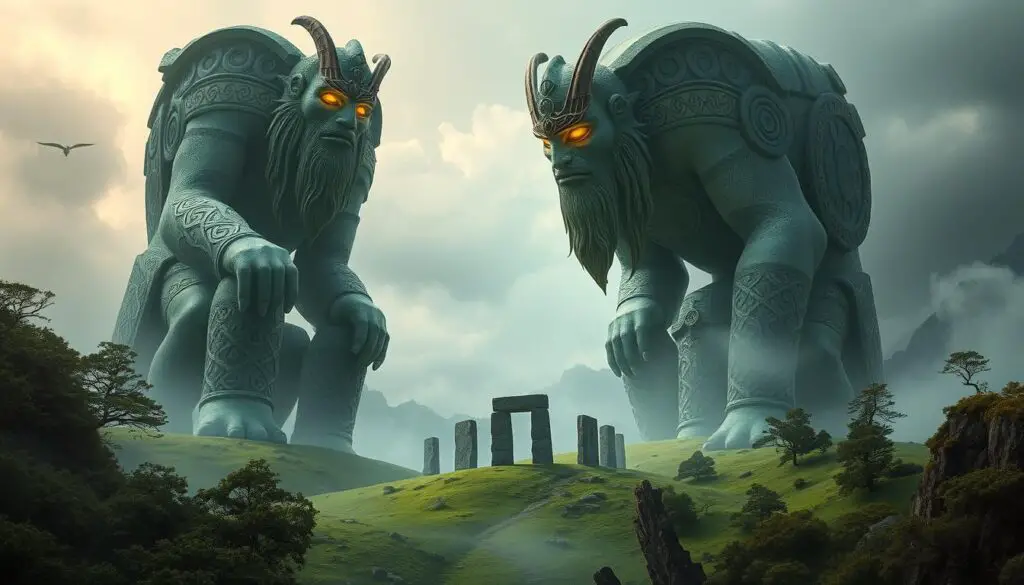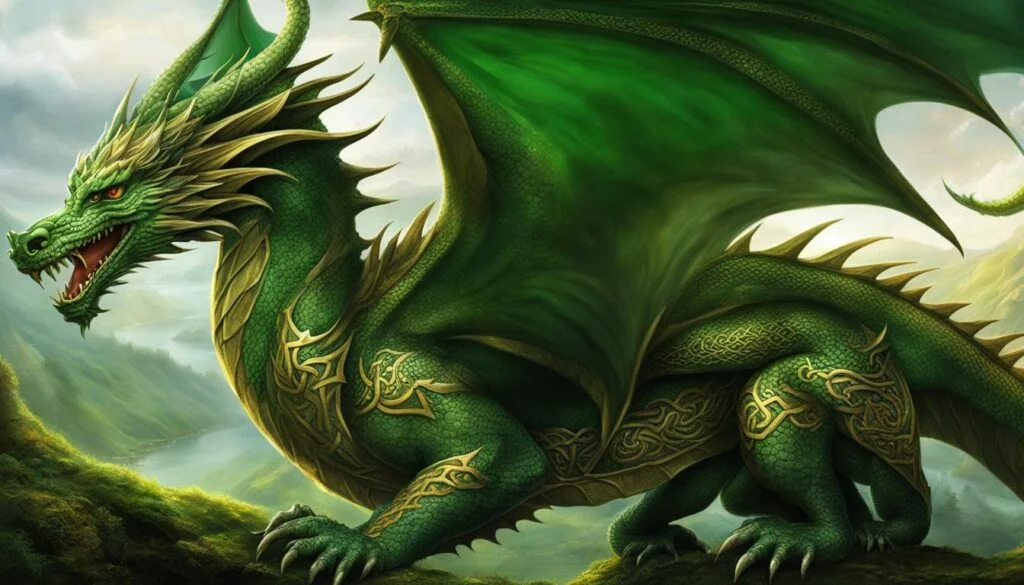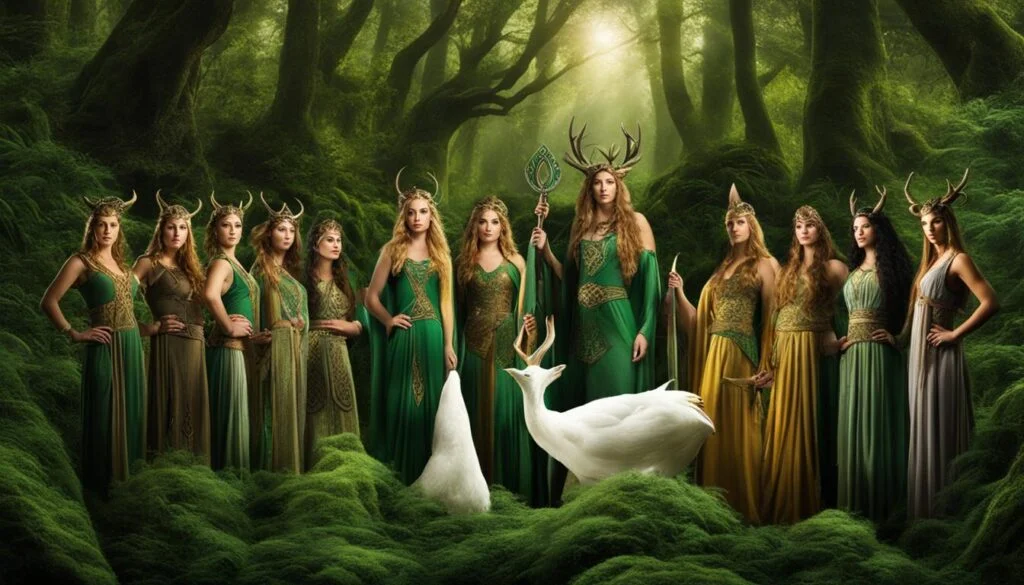In the rich tapestry of Irish folklore, the Firbolgs are seen as legendary giants.
They were among the first people to settle in Ireland. They came from the ancient Muintir Nemid family, who spread across Europe.
Those who were enslaved in Greece later called themselves Firbolg and returned to Ireland with a big impact.
The stories of the Firbolgs, found in the Lebor Gabála Érenn, show their key role in shaping Ireland.
They worked with other tribes and magical beings, showing how Celtic myths are all connected.
This makes the Firbolgs some of Ireland’s most powerful and famous mythological figures.
Key Takeaways
- The Firbolgs are key in Celtic mythology, known as legendary giants and early Irish settlers.
- They come from the Muintir Nemid family and returned to Ireland after being enslaved in Greece.
- Their stories in the Lebor Gabála Érenn show their big effect on Irish land and society.
- Their dealings with other tribes and magical beings show the deep connections in Celtic mythology.
- They are celebrated in Irish folklore, showing pre-Christian beliefs and pagan traditions.
Origins of the Firbolgs
The story of the Firbolgs is a key part of Celtic mythology. It tells of the Muintir Nemid, an ancient tribe.
After a tragic event, the Muintir Nemid’s descendants spread across Europe, ending up in Greece.
The Muintir Nemid Connection
The link between the Firbolgs and the Muintir Nemid is crucial.
Thirty survivors of the Muintir Nemid made their way to Greece.
Their journey was tough, shaping a strong heritage that influenced Irish legends.
The Firbolgs, seen as supernatural beings, took on their ancestors’ strength and resilience.
Enslavement in Greece
In Greece, the Firbolgs faced hard times as slaves. They carried heavy loads, earning their name, “men of bags.”
This tough period made them strong and ready for rebellion.
For 230 years, they worked hard, building their strength.
Then, they decided to return to Ireland, their homeland. This journey started a new chapter in their story, linking them to Ireland’s ancient tales.
The Return to Ireland

After 230 years in Greece, the Firbolgs returned to Ireland. They were led by five chieftains, known as Irish giants.
These leaders divided the land into five provinces, shaping Ireland’s future.
Leadership and Division of Land
The Firbolgs settled under their chieftains, dividing the land. Each leader took control of a region, becoming the first rulers.
The Gaileoin, led by Sláine mac Dela, arrived first and ruled Leinster.
Then, Gann and Sengann led 2,000 people to Munster.
The Fir Domnann, under Genann and Rudraige, claimed Connacht and Ulster.
This division made Sláine mac Dela the first High King of Ireland.
Sláine’s reign at Tara started the High Kingship tradition. He was killed in battle a year later, but his legacy lived on.
It set a standard for leadership in Ireland.
The Five Provinces
The land was divided into five provinces by the Firbolgs. Each chieftain ruled a province, with Tara as the central authority.
Eochaid mac Eirc became High King after conflicts and ruled for ten years.
His time was marked by strong governance. The Firbolgs’ work in dividing the land and setting up the High Kingship at Tara was crucial.
Their efforts shaped the Irish provinces and had a lasting impact on Ireland’s culture.
Life in Ireland

The Firbolgs changed ancient Ireland’s history when they arrived. They brought big changes in many areas.
Their mix of Celtic traditions and their own ideas created a culture that shaped Ireland for a long time.
Cultural Impact and Innovations
The Firbolgs made a big mark with their cultural impact. They introduced pointed weapons, a big step forward thanks to Rinnal, an early king.
These changes mixed with Celtic traditions, making a special culture.
Under Eochaid mac Eirc, they made policies that brought prosperity and peace.
These policies led to good weather and plenty of food. This time was full of creativity and new ideas, showing the Firbolgs’ spirit of innovation.
Agricultural Practices
The Firbolgs improved Irish farming a lot. They used the land well, without cutting down many trees.
This way, they got a lot of food from the land.
They divided the land into five parts, making farming better organized.
This helped farming to succeed for a long time.
The Firbolgs’ farming ways mixed with Irish traditions, leaving a lasting mark on Ireland.
The First Battle of Mag Tuired
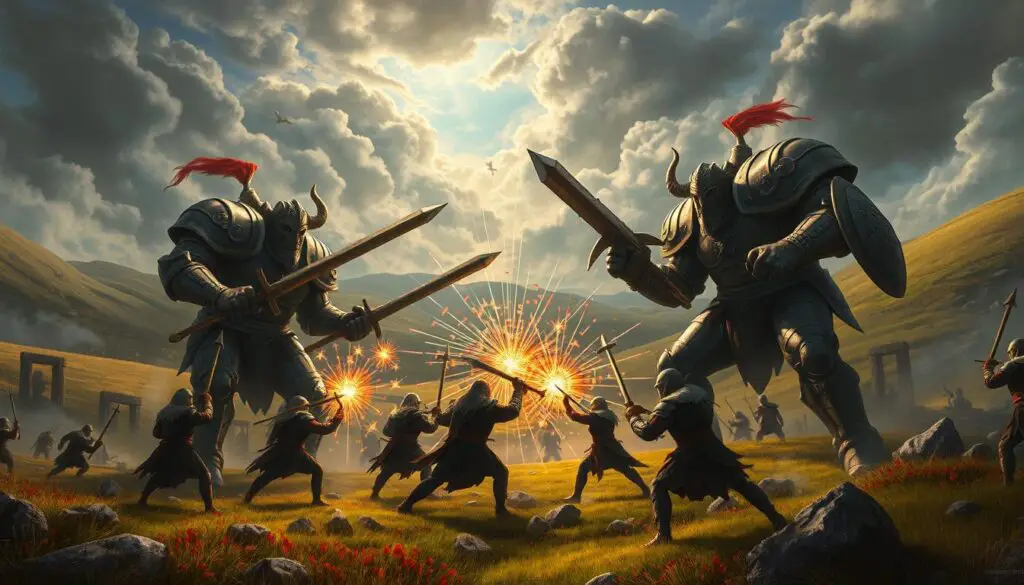
The first Battle of Mag Tuired was a key event in ancient legends. It was a turning point in Irish mythology.
The Tuatha Dé Danann, led by King Nuada, wanted half of Ireland from the Firbolgs.
The Firbolgs refused, leading to a four-day battle filled with supernatural events.
During this battle, Nuada, the Tuatha Dé Danann king, lost his arm to Sreng, a brave Firbolgs warrior.
This injury weakened Nuada and changed the leadership among the Tuatha Dé Danann. In their culture, a king without an arm couldn’t rule.
The Firbolgs fought bravely but lost the battle. Their High King Eochaid was killed by The Morrígan, a goddess of fate and death.
This defeat changed the balance of power in Irish mythology. It showed the Firbolgs’ strength and their fight against gods.
The Lebor Gabála Érenn, or the Book of Invasions, tells us about this battle. It talks about the settlement of Ireland by different groups, including the Firbolgs and the Tuatha Dé Danann.
This book is full of stories of supernatural battles and deep historical meanings.
Scholars see it as a mix of history and myth, with stories of gods and heroes.
The first Battle of Mag Tuired didn’t just end with the Firbolgs’ defeat. It led to the rise of the Tuatha Dé Danann.
This battle shows the themes of bravery, resilience, and the mix of myth and history in Irish stories.
Firbolgs in Celtic Mythology
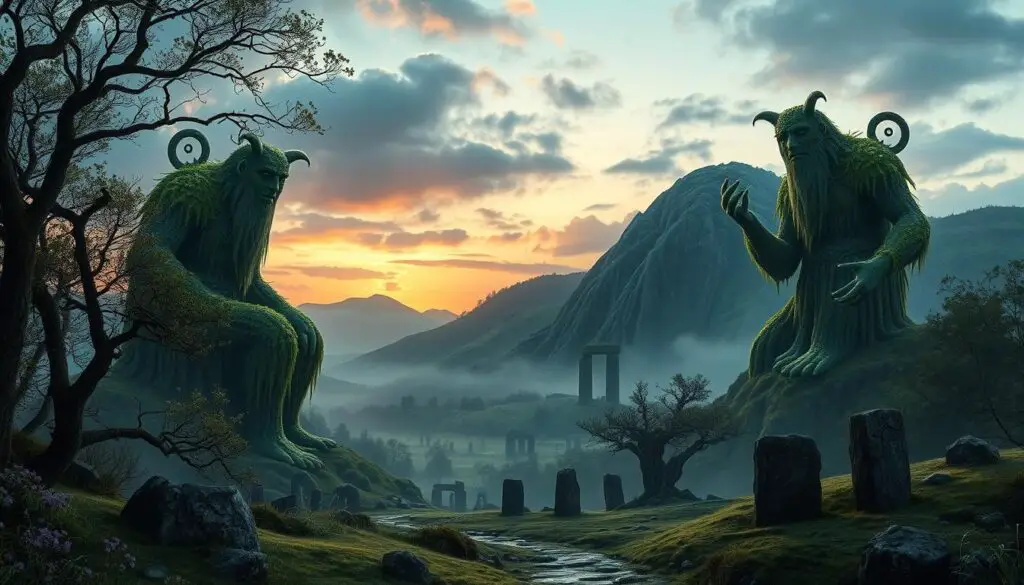
The story of the Firbolgs is part of the Mythological Cycle, a key part of Irish mythology.
This cycle tells of invasions that deeply shaped Ireland’s past. The Firbolgs were the third group to invade Hibernia, adding to Ireland’s cultural richness.
The Mythological Cycle
In the Mythological Cycle, the Firbolgs’ story is a blend of myth and reality.
They came from Greece, where they were slaves before escaping.
They sailed to Ireland, becoming a key part of Celtic mythology.
They split into three groups: Firdomnann, Firgalion, and Firbolg.
Each group settled in different parts of Ireland.
Lebor Gabála Érenn: The Book of Invasions
The Lebor Gabála Érenn, or “The Book of Invasions,” tells of the Firbolgs’ arrival.
It compares their journey to the biblical Exodus. The book says the Firbolgs ruled Ireland, trading bronze and farming.
They worked with and fought the Fomorians, adding to Ireland’s history.
Historical Versus Mythological Interpretations
Scholars debate the Firbolgs’ historical truth. Their story is deeply rooted in Celtic mythology.
Yet, some believe they might represent real people whose stories were mythologized.
The Lebor Gabála Érenn shows how Irish identity evolved. Myth and history merged to honor the Firbolgs’ impact on Ireland.
Connection to the Belgae
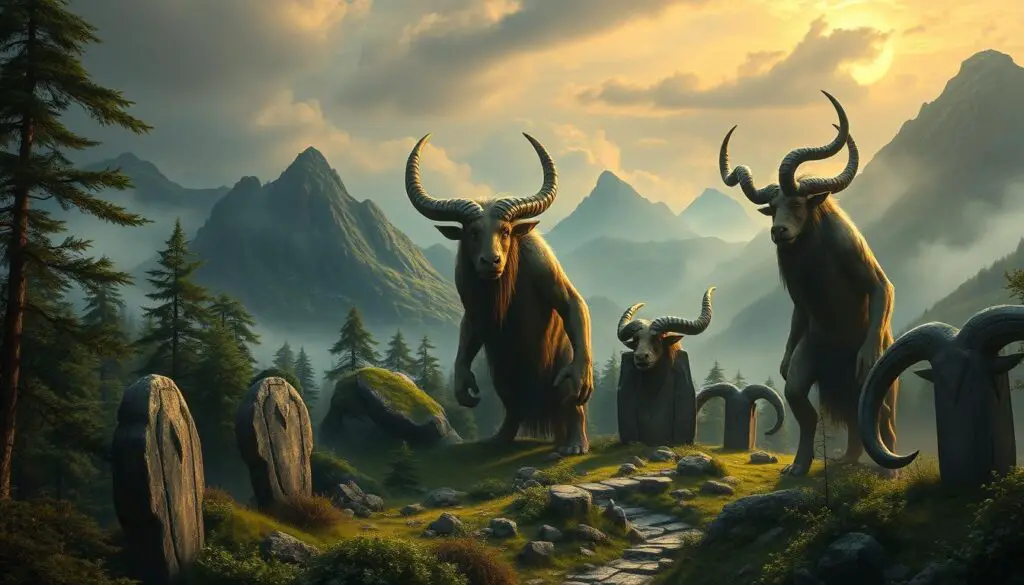
The Firbolgs in Celtic mythology have always caught the eye of historians and mythologists.
They are especially interesting because of their possible link to the Belgae tribes in northern Europe.
Many etymological links suggest this connection. The name “Firbolg” might be related to the Gaulish Belgae, showing a possible shared history or culture.
Possible Etymological Links
The name “Fir Bolg” means “men of bags.” This could link them to the Belgae, a big Celtic group.
T.F. O’Rahilly thinks the Fir Bolg might be an early group tied to the Érainn, who came to Ireland before the Celts.
Theories and Debates
There are many debates about these connections, mixing fact and fiction.
Some believe the Firbolg are just a myth, made from the Belgae tribes.
But, these ideas are not widely accepted today. Still, the idea that the Firbolgs might be linked to the Belgae keeps sparking interest among Celtic mythology fans.
There are striking similarities between the Firbolgs’ stories and the Belgae’s history.
Caesar wrote about the Belgae in Britain in 55 B.C. This shows they were active in southern England, which could link them to the Firbolgs.
These findings encourage more research, helping us understand the mix of myth and reality.
Firbolgs and the Tuatha Dé Danann
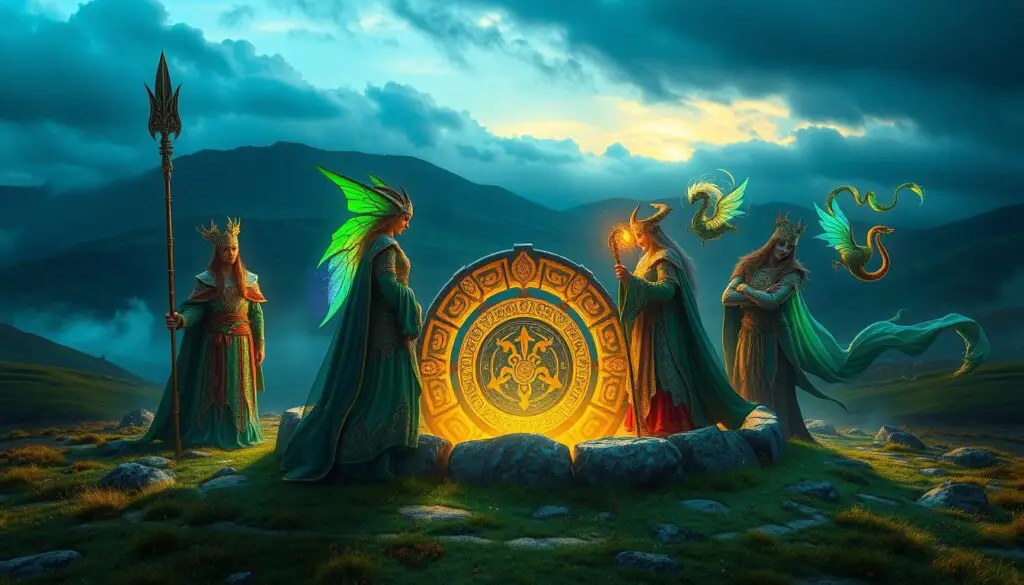
The Firbolgs and the Tuatha Dé Danann were two powerful groups in Celtic mythology.
They fought in the First Battle of Mag Tuired, a key event in their history.
The Tuatha Dé Danann were seen as gods, while the Firbolgs were mortals.
The Tuatha Dé Danann came from four cities: Falias, Gorias, Finias, and Murias.
They became the divine rulers of Ireland. They brought four treasures with them, each with magical powers.
These treasures helped the Tuatha Dé Danann rule over the Irish giants, the Firbolgs.
The four cities were full of wise men who taught skills and knowledge.
Important figures like King Nuada and Manannan son of Lir were part of the Tuatha Dé Danann.
Women like Badb and Macha also played key roles. They showed the power and magic of the Tuatha Dé Danann.
The Tuatha Dé Danann loved the plow, the sun, and the hazel tree.
They divided Ireland into three parts: Coll, Cecht, and Grian. They arrived in Ireland on Beltaine, the first day of spring, with rituals and strategies.
Before the battle, King Eochaid of the Firbolgs tried to make peace with the Tuatha Dé Danann.
He offered them half of Ireland for peace. But the battle lasted four days and the Tuatha Dé Danann won.
This victory made them even more powerful in Celtic mythology.
Firbolgs in Popular Culture
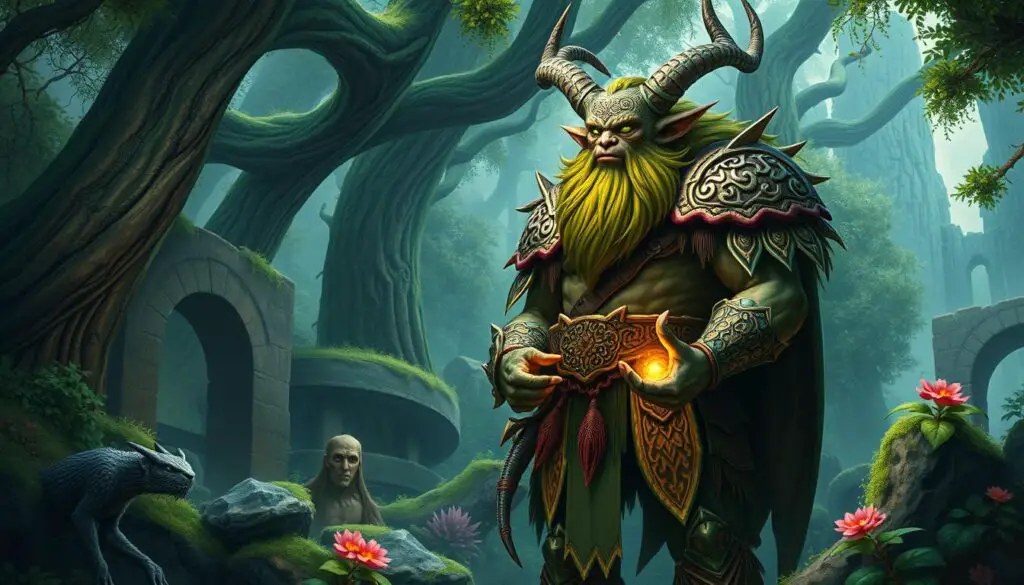
Firbolgs have moved beyond their mythological roots to become big names in today’s pop culture, especially in fantasy gaming.
They are best known in the hit game, Dungeons & Dragons. Here, they are seen as half-giants, known for their kind nature and deep link to nature.
They have a mix of magic and fighting skills, showing a new side of them.
Representation in Dungeons & Dragons
In Dungeons & Dragons, Firbolgs are shown as guardians of the forest, deeply connected to the earth and its animals.
This view is different from their old stories, but keeps their strong nature.
They prefer peace and only fight when needed, just like in Celtic myths.
Comparative Analysis with Mythological Accounts
Comparing the Firbolgs in Dungeons & Dragons with their mythological versions shows both big differences and similarities.
The game takes a new path from the old stories in medieval Irish texts. Yet, it also deepens our understanding of these Celtic beings.
This mix of old and new stories keeps the Firbolgs interesting and shows how myths inspire today’s stories.
Conclusion
The story of the Firbolgs is a key part of Celtic mythology, filled with themes of strength, victory, and change.
These Irish giants have made a big mark on Ireland’s culture. They went from being slaves in Greece to ruling Ireland, showing their fight for freedom and lasting legacy.
Their story, though seen as mythical, touches the heart of Irish heritage.
It tells of a deep fight for who they are and their place in the world.
The mix of history and magical beings makes their story a key part of Celtic mythology, still captivating and inspiring today.
The Firbolgs’ legend, like that of the Tuatha Dé Danann, shows how myths keep culture alive.
Their stories of battles, leadership, and blending into popular culture have made a lasting impact on Ireland’s history.
Reflecting on their epic journey, we see how these ancient tales shape our national identity and heritage, proving the lasting power of myth.
Frequently Asked Questions
Q: What do Firbolgs actually look like?
In Irish mythology, Firbolgs are often depicted as robust, giant-like beings, while in fantasy settings like Dungeons & Dragons, they are portrayed as gentle giant kin with features that hint at their fey ancestry, such as muted earthy colors and large eyes.
Q: Who are the firbolgs in Irish mythology?
Firbolgs are a race of mythical beings in Irish mythology, described as one of the early settlers of Ireland. They are depicted as farmers and warriors who were involved in several significant battles.
Q: What gods do firbolgs worship?
In Irish mythology, the Firbolgs worshipped the Tuatha Dé Danann, the pantheon of Irish gods. In fantasy adaptations, they are often depicted as worshipping nature deities and spirits.
Q: Can firbolgs be evil?
Firbolgs in mythology are not typically described as inherently evil but are complex characters with motivations that vary. In fantasy literature and games, their alignment can range based on their individual personality and circumstances.
Q: What are the personality traits of firbolgs?
Firbolgs are often portrayed as being wise, cautious, and inherently good-natured. They value privacy, peace, and are closely connected to nature and the forest in which they reside.
Q: Are Firbolg furry?
In most fantasy representations, Firbolgs are not particularly furry. They are often depicted with rugged, textured skin but might have patches of fur, depending on the interpretation.
Q: Is Firbolg a giant or fey?
Firbolgs are a mythical race that straddles the line between giants and fey. They have giant-like features but are also deeply connected to the fey due to their nature-oriented and mystical attributes.
Q: Do firbolgs have horns?
Typically, Firbolgs do not have horns according to traditional mythology. However, in fantasy genres like role-playing games, some depictions might include horns to enhance their mystical and wild nature.


